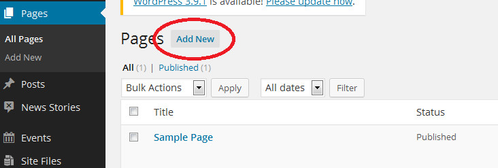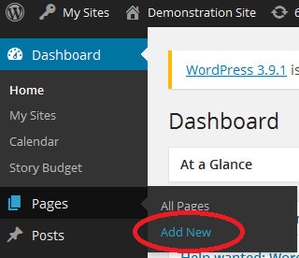There are two modes of Page creation in Zeus: the HTML Editor provides a more traditional WYSIWYG editor, while Building Blocks allow for a more visual, modular approach to page development.
The HTML Editor is available to all site administrators. The Building Block view is available to Editors. Both views are also used in other areas of Zeus.
Creating a New Page
- Once in Zeus, navigate to your Community Site.
- Create a new empty Page:
- Look along the left Toolbox menu. Select 'Pages' from the menu. Then, select the 'Add New' button.
- Or, move your mouse over 'Pages' and click 'Add New'.
- Look along the left Toolbox menu. Select 'Pages' from the menu. Then, select the 'Add New' button.
- A blank web page with an HTML Editor appears. Enter information as appropriate.
- Select 'Save' to save a draft of the Page. This must be done once to define some additional options for the Page.
- Select 'Edit' to the right of 'Status' to change the status of the document.
- Author: Options are Draft, or In Review. Use Draft to signal to other Site Administrators that creation is in-progress. Use In Review to signal to Editors that the document is ready for checking, style modifications, etc.
- Editor: In addition to page modes for Authors, Editors can
- Select a Parent. The Parent will help define the slug (URL of the web page) and if the page will appear in the site's navigation, the Parent will define the default location of the Page in the community site's menu.
- Select a Template. Select the 'select a template' link to choose the Template to use. Templates are created by Editor's and define layout and secondary content for a Page.
- Enter a number for Order. The Order defines a default listing order of Pages relative to each other in menus and lists of links. Note than in Navigation Menus, order can be overridden by editing a Menu.
- Select 'Edit' to the right of 'Status' to change the status of the document.
- Edit the Page's Permalink to define a user-friendly web address for the Page. Ensure the name is all lowercase, with no spaces. If whitespace is requried, use a hyphen (-) or underscore (_).
- Select a Featured Image to choose an image to appear near the top of the Page.
- Depending on the workflow of your office, notifications on page update may be appropriate. At the bottom of the Page view, look for 'Notifications'. Specify users, or groups which should be notified when the page being edited is updated, or a comment has been added.
- Example 1: To notify one Site Administrator that a page has been modified, look under the Users heading and either select the checkbox to the right of each user, or enter the first few letters of a username into the 'Search...' box.
- Example 2: To send a notification to all Editors in a Community Site, under the 'User Groups' heading, select the checkbox to the right of each kind of Site Administrator, either 'Authors' or 'Editors'.
- Select 'Save' at the top of the page to save all changes to the Page, and send any notifications which may have been chosen.
Once the Page ahs been saved, a message will appear indicating a successful save. Select 'View Page' to view the current version of the page.
IMPORTANT NOTE FOR EDITORS: When creating a Page, there will be access to both the HTML Editor, and the Build tab. Content entered into the HTML Editor does not automatically appear in the Build view. Content in the Build view does not automatically become usable in the HTML Editor.


